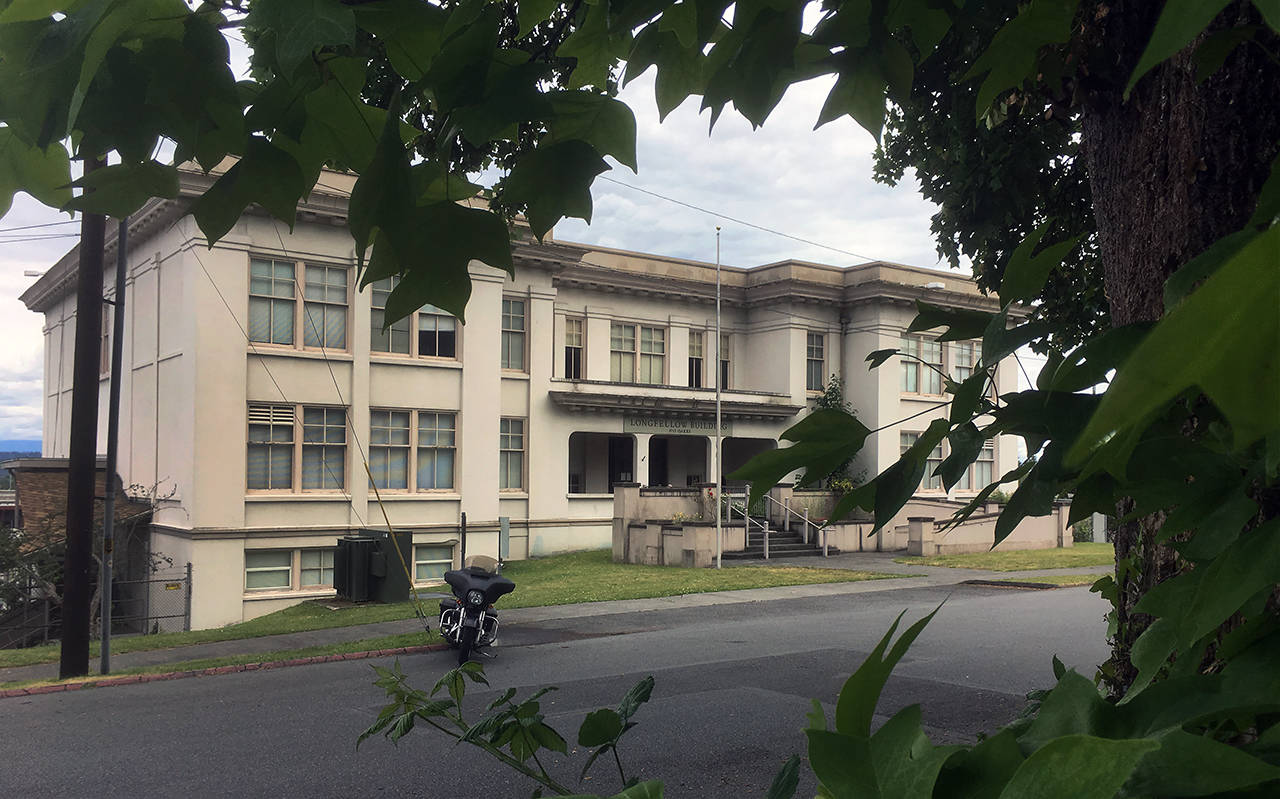By The Herald Editorial Board
The Longfellow Building, the Everett School District’s 108-year-old school perched above Memorial Field, got a tentative reprieve from its march toward demolition Tuesday night as the Everett School Board voted against a proposal to offer some of its contents for salvage, including a vintage red wall siren the city fire department had expressed interest in.
The 4-1 vote came with an unofficial commitment by the board to wait a year before again considering the building’s tear-down, one that follows eight years of consideration on whether to renovate Longfellow for use by the district, sell it or demolish it.
The decision to wait yet another year in hopes of finding a responsive buyer puts off the decision until after a new superintendent will have started work and will have her or his hands full with a bond campaign for a desperately needed fourth high school and other school improvements and the implementation of necessary reshuffling of high school boundaries until that school is built, not to mention the continuing challenges of educating more than 20,000 students.
As it has before, the board heard arguments against the wrecking ball Tuesday afternoon, district residents asking officials to consider its history and the possibility that a buyer could be found to renovate it and find a use that honors that history, as well as offers to assist in that search.
“Saving it is the right thing to do,” Everett history enthusiast and chronicler Jack O’Donnell, himself a former school district student, told the board. “History is important.”
The building does have historical if not architectural significance; notable alumni include Sen. Henry M. “Scoop” Jackson and “Scandihoovian” entertainer Stan Boreson. But the building hasn’t been used to teach children since 1971, and has fallen into disrepair since it was cleared of administration staff prior to the move to the district’s nearby Community Resource Center in 2013.
At least two offers have been made for the building, including one that would have repurposed the building as the Everett Museum of History. But even with a pledge of $3 million in support from a former Everett resident’s trust, the district considered the offer nonresponsive, short of the money that would have been required to compensate the district and allow for the building’s renovation. Proponents of the history museum have since announced plans for a downtown location that will arguably serve it better than the Longfellow location would have.
Others have suggested that the Longfellow building could find new life as a restaurant and lodging, along the lines of such renovations undertaken by McMenamin’s elsewhere in the Northwest, including the Anderson School in Bothell.
While such rejuvenations have been successful elsewhere, the building’s size and construction in relation to the costs of renovation and code upgrades may have already been judged as too daunting by such entrepreneurs. For example, the building lacks an elevator, a costly addition it would need for compliance with the Americans with Disabilities Act.
For that same reason, the district has dismissed renovation for future educational purposes. Mike Gunn, the district’s director of facilities and planning, said Longfellow would cost at least $9 million to bring up to code and would require another $5.3 million over the following 20 years for further work.
For the building’s 25,000 square feet, that $9 million works out to a renovation cost of $360 a square foot. The median square footage costs for new school construction in the U.S. run between $210 and $250 a square foot.
Those calling for the building’s preservation have decried the district’s suggestion that once torn down the property will be used for parking. Other than the building’s footprint, and that of an annex next to it, the property already is used for parking of some school district buses and other district vehicles and for Memorial Stadium events.
It’s a mundane use, but not unnecessary, especially on game nights when two of the three high schools compete at the stadium.
And it’s not its only potential use. School board member Pam LeSesne, the lone vote to allow the sale of surplus items from the building, said the district could well have plans for the property beyond parking, especially as it considers such needs as an early learning center, a district priority.
“A parking lot isn’t its only future,” LeSesne said.
Property is at a premium for a growing district serving a city that is growing just as quickly. What land the district sells now would have to be replaced later — likely at a higher price — or acquired through eminent domain.
Putting off the decision isn’t necessarily fraught with immediate consequences for the district. But costs add up. It spends about $6,300 a month for security and minimal maintenance, yet it wouldn’t be hard for the district to find a use for the $75,000 spent over the course of a year.
The district has made a fair effort to see if a buyer could be found. And it’s been careful to remove items from the school that can be used in a display that honors the building’s history and the memory of its past students.
Continuing to put off a decision, however — as painful as it may be for lovers of local history — could eventually come at a cost to Everett’s students.
Talk to us
> Give us your news tips.
> Send us a letter to the editor.
> More Herald contact information.

























